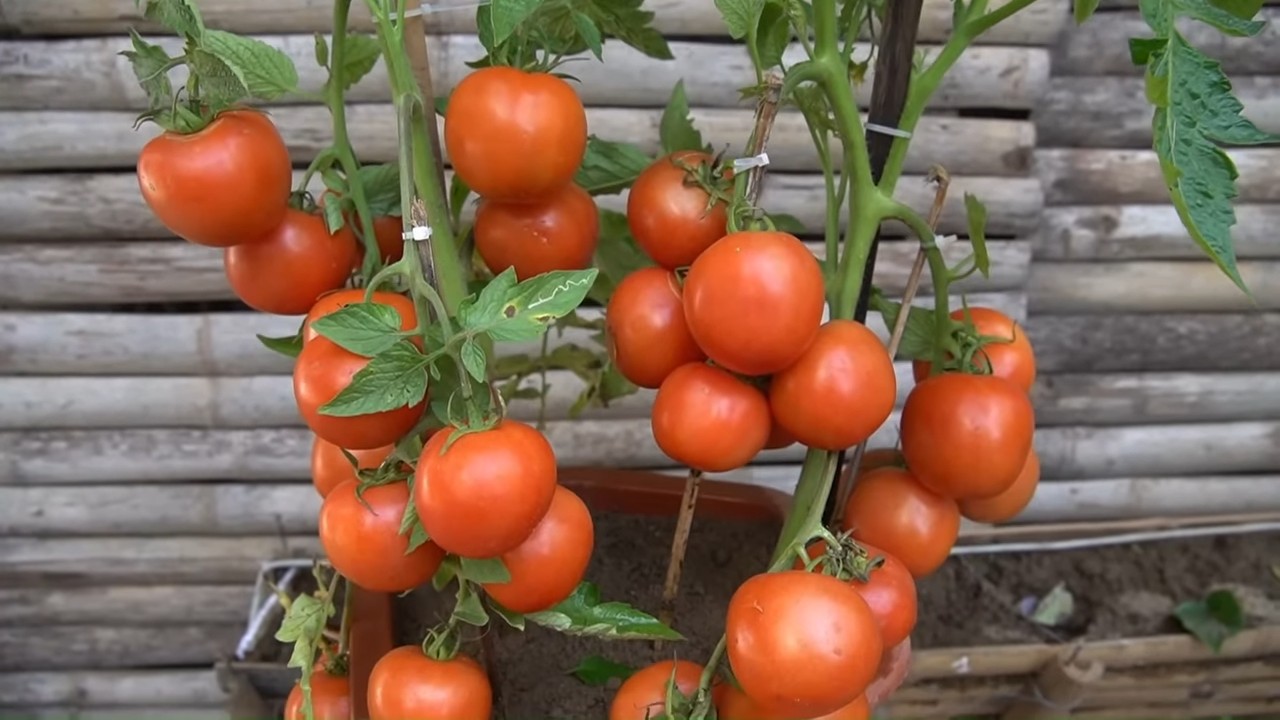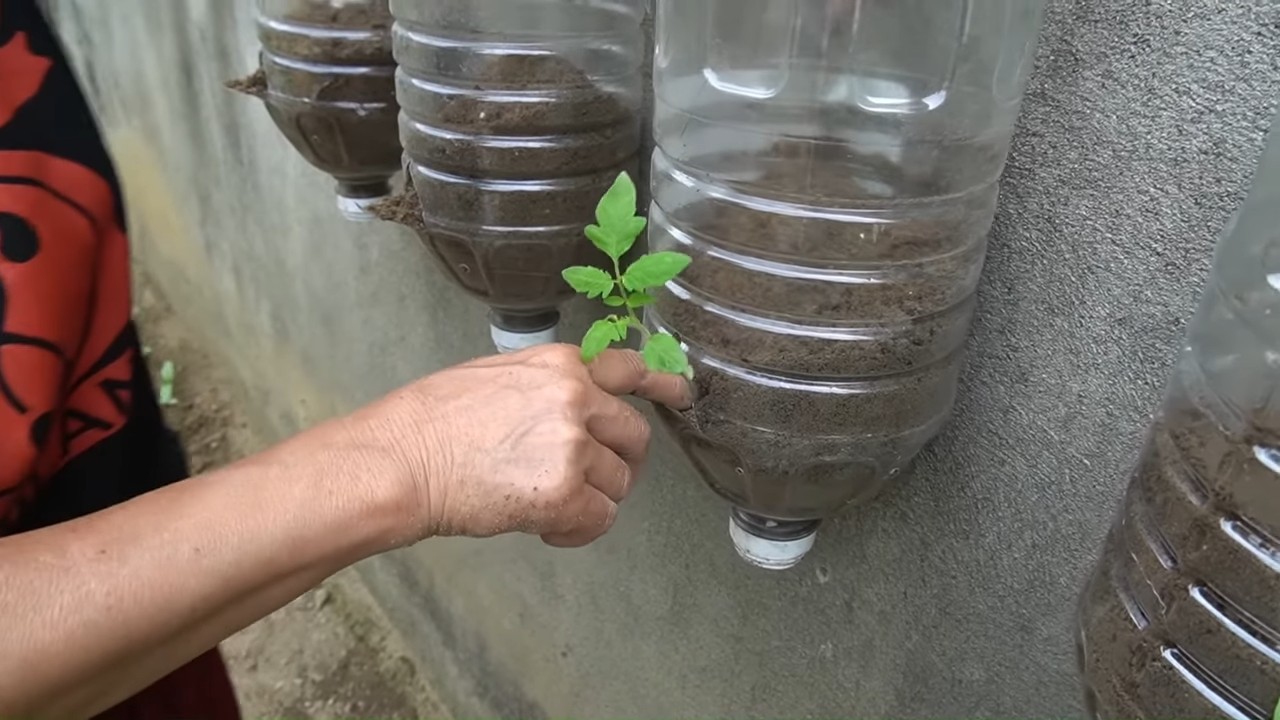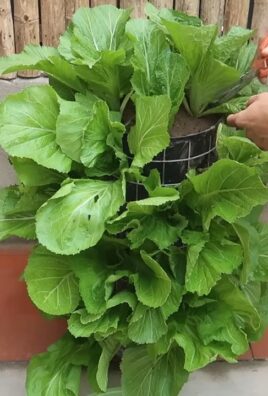Vertical tomato gardening system: Ever dream of plucking juicy, sun-ripened tomatoes right from your own backyard, even if you’re short on space? I know I have! Forget sprawling vines taking over your garden; we’re going vertical! This DIY guide will unlock the secrets to creating your very own space-saving, high-yielding vertical tomato garden.
Growing tomatoes has been a beloved pastime for centuries, with roots tracing back to South America. From humble beginnings, these vibrant fruits have become a staple in cuisines worldwide. But let’s face it, traditional tomato gardening can be a bit of a land hog. That’s where the brilliance of a vertical system comes in.
Why do you need this DIY trick? Because a vertical tomato gardening system is the answer to maximizing your harvest, regardless of your garden’s size. Whether you have a sprawling backyard or just a small balcony, this method allows you to grow more tomatoes in less space. Plus, it’s easier on your back, reduces soil-borne diseases, and looks fantastic! I’m excited to share my favorite tips and tricks for building your own vertical tomato paradise. Let’s get started!

DIY Vertical Tomato Gardening System: Grow Up, Not Out!
Hey there, fellow gardening enthusiasts! Are you dreaming of juicy, sun-ripened tomatoes but short on space? Or maybe you just want to try something a little different this year? Well, I’ve got the perfect solution for you: a DIY vertical tomato gardening system! This project is not only space-saving but also adds a unique aesthetic to your garden or balcony. Plus, it’s surprisingly easy to build. Let’s get started!
What You’ll Need: The Supply List
Before we dive in, let’s gather all the necessary materials. This will save you time and frustration later on.
* PVC Pipes: You’ll need a large diameter PVC pipe (e.g., 6-inch diameter) for the main structure and smaller diameter PVC pipes (e.g., 2-inch or 3-inch diameter) for the planting holes. The length of the large pipe depends on how tall you want your vertical garden to be. I recommend starting with a 5-6 foot length.
* PVC End Cap: One end cap to seal the bottom of the large PVC pipe.
* PVC Cement: To glue the end cap securely to the pipe.
* Drill with Hole Saw Attachment: The hole saw should be slightly larger than the diameter of your smaller PVC pipes.
* Measuring Tape: For accurate measurements and spacing.
* Marker or Pen: To mark the locations for the planting holes.
* Safety Glasses: Always protect your eyes when working with power tools.
* Gloves: To protect your hands.
* Landscape Fabric or Burlap: To line the inside of the large PVC pipe and prevent soil from washing out.
* Staple Gun: To secure the landscape fabric to the PVC pipe.
* Potting Soil: High-quality potting soil is crucial for healthy tomato growth.
* Tomato Seedlings: Choose your favorite tomato varieties! I personally love cherry tomatoes for vertical gardening.
* Gravel or Small Rocks: For drainage at the bottom of the pipe.
* Watering Can or Hose: For watering your tomato plants.
* Optional: Decorative paint or sealant to customize the look of your vertical garden.
* Optional: Zip ties or rope to secure the structure to a fence or support.
Step-by-Step Instructions: Building Your Vertical Tomato Garden
Okay, now for the fun part! Let’s build this vertical tomato garden.
1. Prepare the Large PVC Pipe:
* First, clean the large PVC pipe thoroughly with soap and water to remove any dirt or debris.
* If you plan to paint or seal the pipe, now is the time to do it. Let it dry completely before moving on. This step is optional, but it can add a personal touch to your garden.
* Once the pipe is clean and dry (or painted), attach the PVC end cap to the bottom of the pipe using PVC cement. Follow the instructions on the cement container for proper application. Make sure it’s a tight seal!
* Let the cement dry completely before proceeding. This is important to prevent leaks later on.
2. Mark the Planting Hole Locations:
* Use your measuring tape and marker to mark the locations for the planting holes on the large PVC pipe.
* Space the holes evenly around the pipe, leaving enough room between them for the tomato plants to grow. I recommend spacing them about 12-18 inches apart vertically and staggering them around the circumference of the pipe.
* Consider the mature size of your chosen tomato varieties when determining the spacing. Larger varieties will need more space.
* Double-check your measurements before drilling!
3. Drill the Planting Holes:
* Put on your safety glasses and gloves. Safety first!
* Attach the hole saw attachment to your drill.
* Carefully drill the planting holes at the marked locations.
* Take your time and apply even pressure to avoid cracking the PVC pipe.
* Smooth out any rough edges around the holes with sandpaper or a file.
4. Line the Inside of the Pipe:
* Cut the landscape fabric or burlap to fit the inside of the large PVC pipe. You’ll want it to be long enough to line the entire length of the pipe.
* Use the staple gun to secure the fabric to the inside of the pipe, making sure it covers all the holes. This will prevent the potting soil from washing out when you water the plants.
* Overlap the edges of the fabric slightly to ensure complete coverage.
5. Add Drainage and Soil:
* Pour a layer of gravel or small rocks into the bottom of the pipe to provide drainage. This will help prevent root rot.
* Fill the pipe with high-quality potting soil, leaving a few inches of space at the top.
* Gently tamp down the soil to remove any air pockets.
6. Plant Your Tomato Seedlings:
* Carefully remove the tomato seedlings from their containers.
* Gently loosen the roots before planting.
* Plant each seedling in a planting hole, making sure the roots are covered with soil.
* Water the seedlings thoroughly after planting.
7. Secure and Position Your Vertical Garden:
* Choose a sunny location for your vertical tomato garden. Tomatoes need at least 6-8 hours of sunlight per day.
* If necessary, use zip ties or rope to secure the structure to a fence, post, or other support. This will prevent it from tipping over, especially when the tomato plants get large and heavy.
* Make sure the structure is stable and secure before leaving it unattended.
Maintaining Your Vertical Tomato Garden: Tips for Success
Now that your vertical tomato garden is built and planted, here are some tips to keep your plants healthy and thriving:
* Watering: Water your tomato plants regularly, especially during hot, dry weather. Check the soil moisture by sticking your finger into the soil. If it feels dry, it’s time to water. Water deeply, allowing the water to drain out of the bottom of the pipe.
* Fertilizing: Fertilize your tomato plants every 2-3 weeks with a balanced fertilizer. Follow the instructions on the fertilizer container for proper application.
* Pruning: Prune your tomato plants regularly to remove suckers (the small shoots that grow between the main stem and the branches). This will help improve air circulation and prevent diseases.
* Pest Control: Keep an eye out for pests, such as aphids, whiteflies, and tomato hornworms. Treat any infestations promptly with insecticidal soap or other appropriate pest control methods.
* Support: As the tomato plants grow, they may need additional support. You can use tomato cages or stakes to help support the branches and prevent them from breaking under the weight of the fruit.
* Sunlight: Ensure your vertical garden receives adequate sunlight. If the plants are not getting enough sunlight, consider moving the structure to a sunnier location.
* Rotation: If you plan to reuse your vertical garden next year, be sure to rotate your crops. Avoid planting tomatoes in the same location year after year, as this can deplete the soil of nutrients and increase the risk of diseases.
Troubleshooting: Common Issues and Solutions
Even with the best care, you may encounter some challenges along the way. Here are some common issues and how to address them:
* Yellowing Leaves: Yellowing leaves can be a sign of overwatering, underwatering, nutrient deficiency, or disease. Check the soil moisture and adjust your watering schedule accordingly. Fertilize the plants with a balanced fertilizer. If you suspect a disease, treat the plants with an appropriate fungicide.
* Blossom End Rot: Blossom end rot is a condition that causes the bottom of the tomatoes to turn black and leathery. It is usually caused by a calcium deficiency. To prevent blossom end rot, add calcium to the soil before planting and water the plants consistently.
* Pest Infestations: Pests can quickly damage tomato plants. Inspect your plants regularly for signs of pests and treat any infestations promptly.
* Slow Growth: Slow growth can be caused by a variety of factors, including poor soil, inadequate sunlight, and pests. Make sure your plants are getting enough sunlight and nutrients. Improve the soil with compost or other organic matter. Control any pests that may be affecting the plants.
Variations and Customizations: Make It Your Own!
The beauty of DIY is that you can customize the project to suit your own needs and preferences. Here are some ideas for variations and customizations:
* Different Pipe Sizes: Experiment with different sizes of PVC pipes to create a unique look.
* Multiple Pipes: Build multiple vertical gardens and arrange them in a row or cluster.
* Paint and Decoration: Paint the PVC pipes with bright colors or add decorative elements, such

Conclusion
So, there you have it! Creating your own vertical tomato gardening system isn’t just a fun weekend project; it’s a game-changer for anyone looking to maximize their yields, conserve space, and add a touch of rustic charm to their garden or balcony. We’ve walked you through the process, highlighting the ease and affordability of building a system that’s perfectly tailored to your needs.
But why is this DIY trick a must-try? Let’s recap the compelling reasons:
* Space Optimization: If you’re dealing with limited space, a vertical garden is your best friend. It allows you to grow a surprising number of tomato plants in a fraction of the area required by traditional gardening methods. This is especially beneficial for apartment dwellers, urban gardeners, or anyone with a small patio or balcony.
* Increased Yields: Vertical gardening often leads to higher yields. The improved air circulation and sunlight exposure, coupled with the ease of watering and fertilizing, create an optimal environment for tomato growth.
* Pest and Disease Control: By elevating your tomato plants, you’re reducing their contact with soil-borne pests and diseases. This can significantly minimize the need for pesticides and other treatments, resulting in healthier, more organic tomatoes.
* Aesthetic Appeal: Let’s face it, a vertical tomato garden is visually stunning. It adds a unique and attractive element to your outdoor space, transforming it into a lush and vibrant oasis.
* Cost-Effectiveness: Building your own vertical tomato gardening system is significantly cheaper than buying a pre-made one. You can repurpose materials, save money, and enjoy the satisfaction of creating something yourself.
Now, let’s talk about variations and suggestions to personalize your vertical tomato gardening system:
* Material Choices: While we’ve focused on using readily available materials like pallets or repurposed containers, feel free to experiment with other options. Consider using PVC pipes, stacked planters, or even hanging baskets to create a unique and eye-catching design.
* Plant Selection: While tomatoes are the star of the show, you can also incorporate other companion plants into your vertical garden. Herbs like basil, oregano, and thyme are excellent choices, as they attract beneficial insects and deter pests. You can also add flowers like marigolds or nasturtiums for a pop of color and added pest control.
* Irrigation Systems: To simplify watering, consider installing a drip irrigation system. This will ensure that your tomato plants receive a consistent and adequate supply of water, without the need for manual watering. You can easily create a DIY drip irrigation system using readily available components.
* Support Structures: Depending on the variety of tomatoes you’re growing, you may need to provide additional support. Use stakes, trellises, or cages to help your plants stay upright and prevent them from collapsing under the weight of the fruit.
We wholeheartedly encourage you to try this DIY vertical tomato gardening system. It’s a rewarding and fulfilling project that will provide you with an abundance of delicious, homegrown tomatoes. Don’t be afraid to get creative, experiment with different designs, and adapt the system to suit your specific needs and preferences.
Most importantly, we want to hear about your experience! Share your photos, tips, and stories with us in the comments section below. Let’s create a community of vertical tomato gardeners and inspire others to embrace this innovative and sustainable gardening technique. Happy gardening!
FAQ
What are the best tomato varieties for vertical gardening?
Determinate or bush tomato varieties are generally better suited for vertical gardening, especially in smaller containers. These varieties grow to a compact size and produce their fruit all at once. Some popular determinate varieties include Roma, Celebrity, and Patio. Indeterminate or vining tomato varieties can also be grown vertically, but they require more support and pruning. Cherry tomatoes, such as Sweet 100 or Sungold, are excellent choices for hanging baskets or smaller vertical structures. Ultimately, the best variety depends on your personal preference and the size of your vertical garden.
How often should I water my vertical tomato garden?
Watering frequency depends on several factors, including the weather, the type of container you’re using, and the size of your tomato plants. In general, you should water your vertical tomato garden whenever the top inch of soil feels dry to the touch. During hot and dry weather, you may need to water daily or even twice a day. Overwatering can lead to root rot, so it’s important to ensure that your containers have adequate drainage. A good rule of thumb is to water deeply and thoroughly, allowing the excess water to drain out of the bottom of the container. Consider using a moisture meter to accurately assess the soil moisture levels.
What type of soil should I use for my vertical tomato garden?
Use a high-quality potting mix that is well-draining and rich in organic matter. Avoid using garden soil, as it can become compacted in containers and restrict root growth. A good potting mix should contain a blend of peat moss, perlite, and vermiculite. You can also amend the potting mix with compost or other organic materials to improve its fertility and water-holding capacity. Ensure the pH level of the soil is between 6.0 and 6.8 for optimal tomato growth.
How much sunlight do vertical tomato plants need?
Tomato plants require at least 6-8 hours of direct sunlight per day to thrive. Choose a location for your vertical garden that receives ample sunlight throughout the day. If you’re growing tomatoes indoors, you may need to supplement with grow lights. Rotate your plants regularly to ensure that all sides receive equal exposure to sunlight. Insufficient sunlight can lead to leggy growth, reduced fruit production, and increased susceptibility to pests and diseases.
How do I fertilize my vertical tomato garden?
Tomato plants are heavy feeders and require regular fertilization to produce abundant fruit. Start fertilizing your plants a few weeks after transplanting them into your vertical garden. Use a balanced fertilizer that is specifically formulated for tomatoes. Follow the instructions on the fertilizer label carefully, and avoid over-fertilizing, as this can damage your plants. You can also use organic fertilizers, such as compost tea or fish emulsion, to provide your plants with essential nutrients. Side-dress your plants with compost or aged manure every few weeks to maintain soil fertility.
How do I prevent pests and diseases in my vertical tomato garden?
Vertical gardening can help reduce the risk of pests and diseases, but it’s still important to take preventative measures. Inspect your plants regularly for signs of pests or diseases. Remove any infected leaves or fruit immediately. Use organic pest control methods, such as insecticidal soap or neem oil, to control common tomato pests like aphids, whiteflies, and tomato hornworms. Ensure good air circulation around your plants to prevent fungal diseases like powdery mildew and blight. Consider using companion planting to deter pests and attract beneficial insects.
Can I grow other vegetables or herbs in my vertical tomato garden?
Yes, you can definitely grow other vegetables and herbs in your vertical tomato garden! Companion planting can be beneficial for tomato plants, as certain herbs and vegetables can deter pests, attract beneficial insects, or improve soil health. Some good companion plants for tomatoes include basil, oregano, thyme, marigolds, and nasturtiums. Avoid planting tomatoes near members of the cabbage family, such as broccoli, cauliflower, and kale, as they can compete for nutrients. Consider the size and growth habits of other plants when choosing companions for your tomatoes.
How do I prune my vertical tomato plants?
Pruning is essential for maintaining the health and productivity of your vertical tomato plants. Remove suckers, which are small shoots that grow between the main stem and the branches. Suckers can divert energy away from fruit production. Prune away any yellowing or diseased leaves to improve air circulation and prevent the spread of disease. For indeterminate tomato varieties, prune the lower leaves to prevent them from touching the soil. Use clean and sharp pruning shears to avoid spreading disease.
What do I do with my vertical tomato garden at the end of the season?
At the end of the growing season, remove all of the tomato plants from your vertical garden. Clean the containers thoroughly with soap and water to remove any remaining soil or debris. Discard any diseased plant material to prevent the spread of disease. Amend the soil with compost or other organic materials to replenish its nutrients. Store the containers in a dry place over the winter. You can also use the off-season to repair or modify your vertical garden as needed.




Leave a Comment